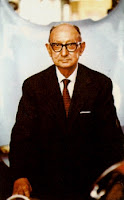 |
| Ugo Zagato |
Real Zagato bodied cars are rare. You can typically identify them by their "double bubble" roofline, shaved streamline doorhandles, and shaved bumpers. Ugo Zagato started the firm post World War 1 fusing streamlined aeronautical technology he had learned during his short lived career in Turin with Pomilio, an aircraft construction company, with automotive design. The firm grew quickly as Zagato's designs piqued the interest of the large manufacturers. In the firms infancy, Zagato was contracted to produce racing bodies for Alfa Romeo. This collaboration produced Alfas 1500 6C, and 1750 6C which were favored by some of the biggest names in racing at that time. Tazio Nouvalari and Enzo Ferrari being two of them. Zagato's pre war efforts produced cars which competed regularly in races like the Mille Miglia. In Fact in the 1938 Mille Miglia over 30 Zagato bodied cars were registered to compete.
Arguably Ugo's magnum opus was the Alfa 2300 8C. This is perhaps one of the most prolific pre war racers in automotive history. Only the mighty Bugatti type 35 and Hitlers silver arrows rival its reputation in prestige and prowess. Ugo was famously quoted as saying, "it is better to be a small boss than an important employee."
During WW2, the Zagato factory was destroyed during a bomb raid. They had been commissioned under Mousolini to produce truck cabs for the war efforts.
Post WW2 however, Zagato was reborn as a new family owned partnership between Ugo and his two sons; Elio and Gianni Zagato. Elio became the master administrator of the firm. Drawing from both his short race car driving history and a newly earned degree in business Administration, Elio had the firm performing both as innovative coachbuilders but also as race chassis engineers as well. It was during this time in Zagato's history that Grand Touring racing became popular.
 |
| Fiat 8V Berlinetta Coupe 'Rapi' design |
Upon servicing the new GT class and with the guidance and administrative expertise of Elio, Zagato was immediately inundated with orders from prominent manufacturers. Privateers and production firms all worked to infuse Zagato's signature wind slicing, aero designs into competition cars. Again the double bubble low drag roofline, streamlined bodywork and what is referred to as a "truncated tail" were developed right in Zagato's plant outside of Milan. The Alfa TZ series 1 and 2 both would carry the evolved "truncated tail" during competition.
Most noteworthy post war collaborations were with Aston Martin, Lancia, and Alfa Romeo. Zagato produced limited volume and prototype cars for Ferrari who was diligently working to bring their preferred design house Pininfarina in house. They also worked for Maserati, Fiat, Lancia, Abarth, Ferrari and Bristol. The specific cars which have interested me over the years are less obscure than some.
Aston Martin DB4 GT Zagato
Alfa Romeo Tubolare Zagato
Alfa Romeo 1900 Sport Zagato
Lancia Fulvia Sport Zagato
These are in my opinion the best representations of what Zagato did best. All fluid, all recessed headlights, all carried a certain style representative of the firms core beliefs. When I look at them I feel like if I ever drove one, I would need to be wearing a well trimmed suit.
On my first date with my (unbeknownst to me at that time) future wife I took her for a short (two hour) drive to a museum of sorts which was displaying a real, one in 19 Aston Martin DB4 GT Zagato. She watched me stare in disbelief for over 2 hours as I attempted to memorize every line, every nuance of style. I was speechless, and an awful date. However I later discovered that though it was a bit long, she felt connected with something so close to my heart. It doesn't always work taking girls to see cars, but beautiful girls like beautiful things and our tastes sometimes are an unsaid compliment.
After the late 70's Zagato faded from view. They continued to collaberate with companies for concepts but failed to get long term production contracts. The late 90's through today we have see a re-invigoration of the firm. Aston Martin and others now have short run production projects with Zagato which I personally hope we see continue the growth and health of one of the worlds most historically significant firms.
I will undoubtedly spend time evaluating each and every car I have outlined in this post, as well as one of my favorite designers whose work is represented in 2 of the above cars; the Aston DB4 GT and the Lancia Fulvia Sport. Ercole Spada.
Scott Madsen
- Zagato's Ghost





No comments:
Post a Comment